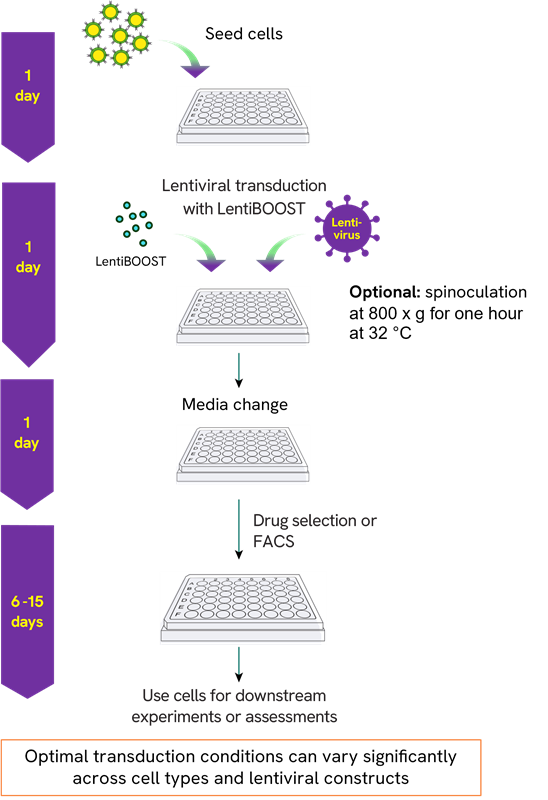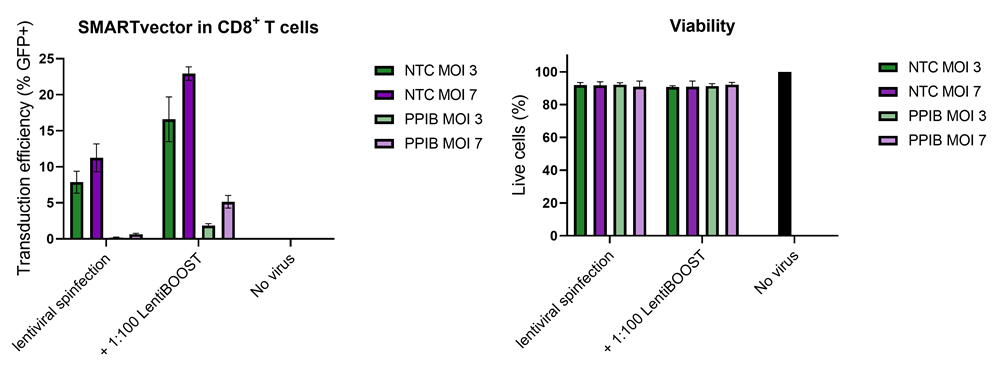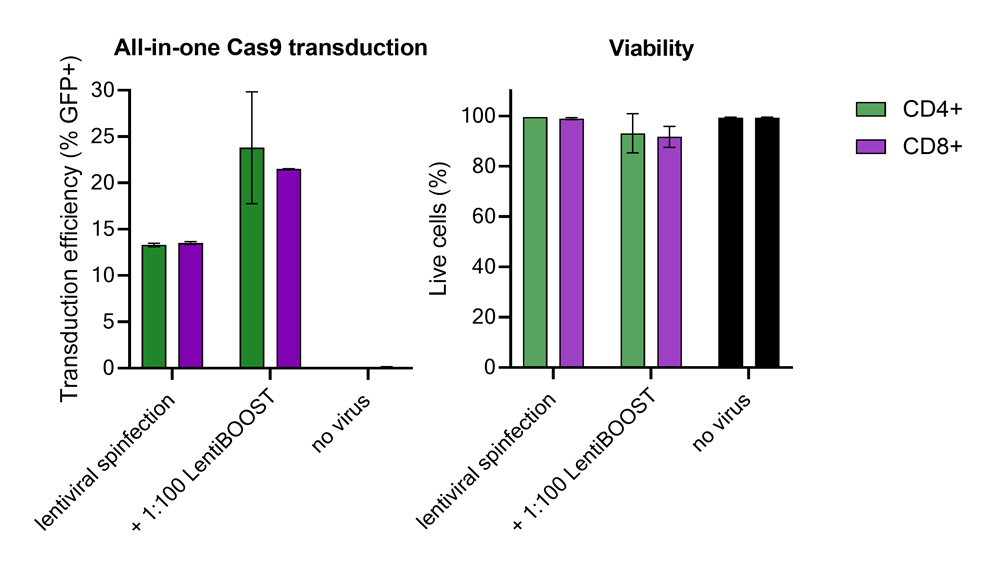- Products
- トランスフェクション試薬とバッファー
LentiBOOST™ Lentivirus Transduction Enhancer, Pharma-Grade
Enhance successful lentiviral transduction of challenging cells and in complex cell engineering
LentiBOOST transduction enhancer can increase successful viral transduction in challenging to transduce cells, or complex cellular engineering work, while preserving cell viability and minimizing the amount of viral particles required for your experiment. LentiBOOST technology is actively used in the production of clinical stage lentivirally delivered therapies, including some approved therapies providing a direct path to therapeutic applicability for your research studies. Tested with Dharmacon Lentiviral reagents.
LentiBOOST Pharma-Grade technology: For research use only. Not for use in diagnostic procedures.
LentiBOOST Lentivirus Transduction Enhancer is a uniquely formulated transduction reagent that can be used with or without lentivirus spinfection in order to increase successful viral transduction events while preserving cell viability. Especially critical for preserving precious primary cells from patient cohorts, or for engineering complex animal models, improving transduction efficiency can save time and costs by increasing the success of each editing/transduction step, or avoid the loss of irreplaceable samples. Additionally, LentiBOOST technology is already used in the manufacturing of a number of clinical stage therapies, providing the opportunity to demonstrate improved workflow applicability to the clinic.
Highlights
- Enhances transduction efficiency up to 90% (Delville et al. 2018).
- Compatible with Dharmacon™ Lentiviral shRNA and CRISPR reagents (see Supporting Data Tab).
- Preserves cell viability especially compared to generic viral transduction enhancement compounds.
To learn more about LentiBOOST technology visit the Revvity LentiBOOST webpage.
Consult our Resources tab for specific recommendation on the use of LentiBOOST technology with Dharmacon lentiviral reagents.
Lentiviral transduction workflow diagrams for transduction of cells with Dharmacon lentiviral reagents using LentiBOOST Lentivirus Transduction Enhancer

The use of LentiBOOST technology is a simple “plug and play” incorporation into existing viral transduction workflows. Protocol should be optimized on an experiment-specific basis.
Improved CD8+ T-cell SMARTvector™ shRNA lentiviral system transduction using LentiBOOST™ Lentivirus Transduction Enhancer

100,000 primary human CD8+ T cells were transduced with either 30,000 (MOI 3, green) or 70,000 (MOI 7, purple) TUs of SMARTVector™ mCMV tGFP Lentiviral Control Particles targeting either NTC or PPIB along with 1:100 LentiBOOST transduction enhancer. Cells were centrifuged at 800 x g for one hour at 32 °C followed by a four hour incubation prior to removal of lentiviral particles and transduction enhancer. Transduction efficiency (%GFP+ out of live cells) and viability were determined 5 days post-transduction by flow cytometry. The addition of LentiBOOST technology markedly improved transduction efficiencies without significantly impacting cell viability.
Improved CD4+ and CD8+ T-cell Edit-R™ All-in-one sgRNA/Cas9 lentiviral system transduction using LentiBOOST™ Lentivirus Transduction Enhancer

100,000 primary human CD4+ and CD8+ T cells from two donors were transduced with 250,000 TUs of Edit-R GFP Delivery controls mCMV along with 1:100 LentiBOOST transduction enhancer. Cells were centrifuged at 800 x g for one hour at 32 °C followed by an overnight incubation prior to removal of lentiviral particles and transduction enhancer. Transduction efficiency and viability were determined 72 hours post-transduction by flow cytometry. The addition of LentiBOOST technology markedly improved transduction efficiencies without significantly impacting cell viability.
Improved transduction of human induced pluripotent stem cells (hiPSCs) with the Strict-R™ Inducible CRISPRa lentiviral system transduction using LentiBOOST™ Lentivirus Transduction Enhancer

10,000 WTC hiPS cells were transduced with either 20,000 (MOI 2, green) or 40,000 (MOI 4, purple) TUs of Strict-R™ Inducible EGFP dCas9-VPR Lentiviral Particles along with 1:100 LentiBOOST transduction enhancer. Cells were centrifuged at 800 x g for one hour at 32 °C followed by an overnight incubation prior to removal of lentiviral particles and transduction enhancer. Transduction efficiency and viability were determined 72 hours post-transduction by flow cytometry. The addition of LentiBOOST markedly improved transduction efficiencies without significantly impacting cell viability.
SMARTvector™ shRNA Lentiviral Reagents
-
SMARTvector Lentiviral shRNA
Guaranteed gene silencing with state-of-the-art shRNA designs and multiple promoter and reporter options. -
SMARTvector Inducible Lentiviral shRNA
The most advanced and flexible single-vector inducible shRNA available for tightly controlled, guaranteed, gene silencing with state-of-the-art shRNA designs and multiple promoter and reporter options.
Edit-R™ Lentiviral Reagents for CRISPR Knockout
-
Edit-R Pre-Designed Lentiviral sgRNA
Single guide RNA expressing vectors for effective and accurate gene knockout guaranteed to edit the target gene of interest. -
Lentiviral Cas9 Nuclease Reagents
Lentiviral CRISPR-Cas9 components for robust gene editing in biologically relevant cell types, available with multiple promotor options, selection options, and, in constitutive and inducible vector systems. -
Edit-R Pre-Designed All-in-one Lentiviral sgRNA/Cas9
Combine sgRNA and Cas9 nuclease expression into a single vector for simplified delivery. Guaranteed to edit the target gene of interest & available with multiple promoter options and selection options.
CRISPRmod™ Lentiviral Reagents for CRISPR Activation
-
CRISPRmod CRISPRa Lentiviral sgRNA
Predesigned CRISPRa lentiviral sgRNAs for highly efficient gene activation in human and mouse cells. -
CRISPRmod CRISPRa Lentiviral dCas9-VPR
Lentiviral particles that deliver deactivated Cas9 (dCas9) fused to transcriptional activators. Available with multiple promoter options.. -
Strict-R™ Inducible CRISPRa Lentiviral dCas9-VPR System
This first-of-its kind tool allows for the controlled upregulation of target genes with high specificity and efficiency. Powered by the combination of the Tet-On 3G and the FKBP12-derived degron systems, this product enables inducible activation and degradation of dCas9-VPR in response to small molecules while minimizing undesirable background expression. -
CRISPRmod CRISPRa All-in-one Lentiviral sgRNA/dCas9-VPR
Combine sgRNA and dCas9-VPR nuclease expression into a single vector for simplified delivery and activation of genes in human cells. Available with multiple promoter options.
CRISPRmod™ Lentiviral Reagents for CRISPR Inhibition
-
CRISPRmod CRISPRi Lentiviral sgRNA
Predesigned CRISPRi lentiviral sgRNAs for highly efficient gene repression in human cells. -
CRISPRmod CRISPRi Lentiviral dCas9-SALL1-SDS3
Lentiviral particles that deliver deactivated Cas9 nuclease (dCas9) fused to our proprietary SALL1-SDS3 repressor construct to block transcription of target genes, without cutting the DNA. Available with multiple promoter options. -
CRISPRmod CRISPRi All-in-one Lentiviral sgRNA/dCas9-SALL1-SDS3
Combine sgRNA and dCas9-SALL1-SDS3 nuclease expression into a single vector for simplified delivery and repression of genes in human cells. Available with multiple promoter options.
- McCall JL, Varney ME, Rice E, Dziadowicz SA, Hall C, Blethen KE, Hu G, Barnett JB, Martinez I. Prenatal Cadmium Exposure Alters Proliferation in Mouse CD4+ T Cells via LncRNA Snhg7. Front Immunol. 2022 Jan 11;12:720635. doi: 10.3389/fimmu.2021.720635. PMID: 35087510; PMCID: PMC8786704.
- Zupančič M, Keimpema E, Tretiakov EO, Eder SJ, Lev I, Englmaier L, Bhandari P, Fietz SA, Härtig W, Renaux E, Villunger A, Hökfelt T, Zimmer M, Clotman F, Harkany T. Concerted transcriptional regulation of the morphogenesis of hypothalamic neurons by ONECUT3. Nat Commun. 2024 Oct 5;15(1):8631. doi: 10.1038/s41467-024-52762-z. PMID: 39366958; PMCID: PMC11452682.
- Simon S, Bugos G, Prins R, Rajan A, Palani A, Heyer K, Stevens A, Zeng L, Thompson KA, Atilla PA, Price JP, Kluesner MG, Jaeger-Ruckstuhl CA, Shabaneh TB, Olson JM, Su X, Riddell SR. Design of sensitive monospecific and bispecific synthetic chimeric T cell receptors for cancer therapy. Nat Cancer. 2025 Apr;6(4):647-665. doi: 10.1038/s43018-025-00927-0. Epub 2025 Mar 17. PMID: 40097658; PMCID: PMC12037409.
- Park TY, Jang Y, Kim W, Shin J, Toh HT, Kim CH, Yoon HS, Leblanc P, Kim KS. Chloroquine modulates inflammatory autoimmune responses through Nurr1 in autoimmune diseases. Sci Rep. 2019 Oct 29;9(1):15559. doi: 10.1038/s41598-019-52085-w. PMID: 31664129; PMCID: PMC6820774.
- Rau CN, Severin ME, Lee PW, Deffenbaugh JL, Liu Y, Murphy SP, Petersen-Cherubini CL, Lovett-Racke AE. MicroRNAs targeting TGF-β signaling exacerbate central nervous system autoimmunity by disrupting regulatory T cell development and function. Eur J Immunol. 2024 Jun;54(6):e2350548. doi: 10.1002/eji.202350548. Epub 2024 Apr 18. PMID: 38634287; PMCID: PMC11156541.
Safety data sheets
Related Products
最先端のshRNAデザインによる遺伝子ノックダウンが保証され、複数のプロモーターおよびレポーターオプションが選択可能です。
ヒトおよびマウスモデルの非常に効率的な遺伝子転写活性化のためのデザイン済みCRISPRa lentiviral sgRNA
